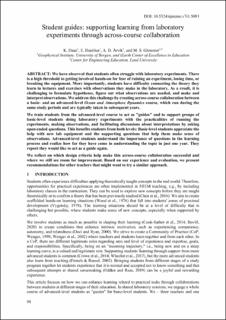| dc.contributor.author | Daae, Kjersti | |
| dc.contributor.author | Darelius, Elin Maria K. | |
| dc.contributor.author | Årvik, Anne Digranes | |
| dc.contributor.author | Glessmer, Mirjam Sophia | |
| dc.date.accessioned | 2024-03-22T13:55:14Z | |
| dc.date.available | 2024-03-22T13:55:14Z | |
| dc.date.created | 2023-10-10T09:42:51Z | |
| dc.date.issued | 2023 | |
| dc.identifier.issn | 2535-4574 | |
| dc.identifier.uri | https://hdl.handle.net/11250/3123908 | |
| dc.description.abstract | We have observed that students often struggle with laboratory experiments. There is a high threshold to getting involved hands-on for fear of ruining an experiment, losing time, or breaking the equipment. More importantly, students have difficulty connecting the theory they learn in lectures and exercises with observations they make in the laboratory. As a result, it is challenging to formulate hypotheses, figure out what observations are needed, and make and interpret observations. We address this challenge by creating across-course collaboration between a basic- and an advanced-level Ocean and Atmosphere Dynamics course, which run during the same study periods and are typically taken in subsequent years. We train students from the advanced-level course to act as "guides" and to support groups of basic-level students doing laboratory experiments with the practicalities of running the experiments, making observations, and facilitating discussions about interpretations by asking open-ended questions. This benefits students from both levels: Basic-level students appreciate the help with new lab equipment and the supporting questions that help them make sense of observations. Advanced-level students understand the importance of questions in the learning process and realize how far they have come in understanding the topic in just one year. They report they would like to act as a guide again. We reflect on which design criteria help make this across-course collaboration successful and where we still see room for improvement. Based on our experience and evaluation, we present recommendations for other teachers that might want to try a similar approach. | en_US |
| dc.language.iso | eng | en_US |
| dc.rights | Navngivelse 4.0 Internasjonal | * |
| dc.rights.uri | http://creativecommons.org/licenses/by/4.0/deed.no | * |
| dc.subject | Laboratorieundersøkelse | en_US |
| dc.subject | Laboratory test | en_US |
| dc.subject | Læring og undervisning i høyere utdanning | en_US |
| dc.subject | Teaching and learning in higher education | en_US |
| dc.title | Student guides: supporting learning from laboratory experiments through across-course collaboration | en_US |
| dc.type | Journal article | en_US |
| dc.type | Peer reviewed | en_US |
| dc.description.version | publishedVersion | en_US |
| dc.rights.holder | Copyright 2023 The Author(s) | en_US |
| cristin.ispublished | true | |
| cristin.fulltext | original | |
| cristin.qualitycode | 1 | |
| dc.identifier.doi | 10.5324/njsteme.v7i1.5093 | |
| dc.identifier.cristin | 2183163 | |
| dc.source.journal | Nordic Journal of STEM Education | en_US |
| dc.relation.project | HK-dir - Direktoratet for høyere utdanning og kompetanse: Program for Studentaktiv læring AKTIV-2021/10219 | en_US |
| dc.subject.nsi | VDP::Matematikk og naturvitenskap: 400 | en_US |
| dc.subject.nsi | VDP::Mathematics and natural scienses: 400 | en_US |
| dc.subject.nsi | VDP::Matematikk og naturvitenskap: 400 | en_US |
| dc.subject.nsi | VDP::Mathematics and natural scienses: 400 | en_US |
| dc.identifier.citation | Nordic Journal of STEM Education. 2023, 7 (1) | en_US |
| dc.source.volume | 7 | en_US |
| dc.source.issue | 1 | en_US |

